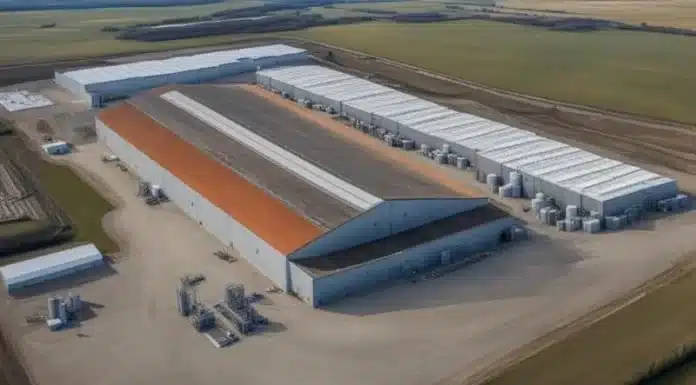When it comes to storing and handling hazardous materials, it is crucial to have secure and compliant chemical warehouse and hazmat warehouse solutions. In the Philippines, there are strict regulations in place to ensure the safety of workers, the environment, and the surrounding community. Whether you’re dealing with flammable, corrosive, reactive, or toxic substances, having a reliable and secure warehouse is essential to prevent accidents, ensure regulatory compliance, and protect your business reputation.
At HashMicro, we understand the importance of secure storage for chemicals and hazardous materials. We offer comprehensive warehouse management systems that meet the specific storage regulations in the Philippines. With our state-of-the-art facilities and expertise in handling hazardous materials, we provide a safe and secure environment for your valuable assets.
Table of Contents

Chemical Warehouse, Hazmat Warehouse: Ensuring Secure Storage and Handling
Chemicals and hazardous materials require specialized storage and handling due to their unique properties and potential risks. With the aim of ensuring safe storage and minimizing the potential for accidents, it is crucial to implement specialized hazmat storage solutions. This section will delve into the factors that make specialized storage necessary, including the potential for chemical reactions, flammability, toxicity, and environmental impact.
Furthermore, it is vital to adhere to hazmat warehousing regulations to ensure regulatory compliance and maintain safety standards. In the Philippines, there are specific laws, standards, and guidelines that companies must comply with when it comes to the storage and handling of hazardous materials. Understanding and complying with these hazmat warehousing regulations is crucial for businesses operating in the Philippines.
By implementing specialized hazmat storage solutions and complying with the relevant regulations, businesses can ensure the secure storage and handling of chemicals and hazardous materials. This not only safeguards the well-being of workers but also minimizes the risk of accidents, protects the environment, and upholds the reputation of the business.
Managing and Operating Hazmat Warehouses
Managing and operating hazmat warehouses requires strict adherence to proper handling and storage protocols in order to minimize the risk of accidents, spills, and contamination. By implementing these protocols and having effective emergency response plans and risk management strategies in place, businesses can ensure the safety of their workers and the surrounding environment while maintaining regulatory compliance.
One of the critical aspects of managing hazmat warehouses is establishing robust handling and storage protocols. This includes following procedures for receiving, inventory management, labeling, and segregation of hazardous materials. By diligently implementing these protocols, businesses can minimize the chances of mishandling and prevent potential hazards from arising.
In the event of an emergency, having a well-defined emergency response plan is crucial. This plan should include clear procedures for notifying and evacuating personnel, as well as protocols for containing and mitigating the impact of any incidents. Regular drills and training sessions should be conducted to ensure that employees are familiar with the emergency response procedures and can act swiftly and effectively in high-stress situations.
Risk management plays a vital role in hazmat warehousing operations. It involves identifying potential hazards, assessing their level of risk, and implementing measures to mitigate or eliminate those risks. This may involve implementing safety controls, conducting regular inspections, and monitoring hazardous materials throughout their lifecycle within the warehouse.
In conclusion, managing and operating hazmat warehouses requires strict adherence to handling and storage protocols, robust emergency response plans, and effective risk management strategies. By following these best practices, businesses can ensure the safety of their workers, protect the surrounding environment, and maintain compliance with regulatory requirements.

Technological Innovations in Hazmat Warehousing
Technological innovations are revolutionizing the field of hazmat warehousing, providing more efficient and secure ways of handling hazardous materials. These advancements not only enhance the safety of workers but also improve operational efficiency and accuracy. Let’s explore some of the latest technological innovations in hazmat warehousing:
- Advanced Monitoring Systems: Real-time monitoring systems play a vital role in ensuring the safety of hazardous materials. These systems can monitor temperature, humidity, and chemical levels, allowing for immediate detection of any abnormalities. By constantly monitoring these factors, businesses can proactively address potential hazards and prevent accidents.
- Automation: Automation technologies are transforming the way hazardous materials are handled in warehouses. Robotic arms and conveyor systems streamline the movement of materials, minimizing human involvement and reducing the risk of accidents. Autonomous vehicles and drones are also being utilized for tasks such as inventory management and material transport, improving efficiency and operational effectiveness.
By embracing these technological innovations, businesses can enhance the safety, efficiency, and accuracy of hazmat warehousing operations. These advancements not only mitigate risks but also improve compliance with hazardous materials handling regulations. With advanced monitoring systems and automation technologies, companies can stay ahead in the ever-evolving field of hazmat warehousing.
Challenges and Best Practices in Hazmat Warehousing
Hazmat warehousing presents unique challenges that require careful consideration to ensure regulatory compliance and implement industry best practices for safety. Navigating the complex regulatory landscape in the Philippines is crucial for businesses engaged in chemical warehousing. Obtaining the necessary permits and licenses, conducting regular inspections, and ensuring proper documentation and reporting are essential steps in maintaining regulatory compliance.
Adhering to industry best practices is paramount to the safety of employees and the overall well-being of the facility. Employee training and education play a crucial role in creating a safe working environment. By equipping employees with the necessary knowledge and skills, businesses can minimize risks and prevent accidents.
The use of personal protective equipment (PPE) is another essential aspect of best practices in hazmat warehousing. Providing appropriate PPE, such as gloves, goggles, and respirators, ensures the safety of employees when handling hazardous materials.
Implementing robust safety management systems is instrumental in hazard identification and risk mitigation. By establishing protocols for proper handling, storage, and emergency response, businesses can effectively minimize potential hazards and mitigate risks. Integrating top warehouse management systems can further streamline these safety processes, ensuring comprehensive oversight and rapid response capabilities.
Overall, challenges in hazmat warehousing can be overcome by prioritizing regulatory compliance and embracing industry best practices for safety. By navigating the regulatory landscape, training employees, providing necessary PPE, and implementing robust safety management systems, businesses can create a secure environment, protect their employees, and build a strong reputation in the industry.
Sustainability and Environmental Considerations
Minimizing the environmental impact of hazmat warehousing is a crucial aspect that should not be overlooked. In addition to prioritizing the safety and security of hazardous materials, businesses must take steps to promote sustainable practices and reduce their ecological footprint.
One key strategy for minimizing the environmental impact is proper waste management. Implementing comprehensive waste management systems ensures that hazardous materials are disposed of safely and responsibly, reducing the risk of contamination and negative environmental consequences.
Another important aspect of sustainable hazmat storage is the use of eco-friendly packaging. By opting for packaging materials that are recyclable or biodegradable, businesses can significantly reduce their contribution to landfill waste and contribute to a more sustainable future.
Furthermore, embracing green technologies can also make a significant difference in the environmental impact of hazmat warehousing. By utilizing energy-efficient equipment and adopting renewable energy sources, businesses can reduce their energy consumption and carbon emissions, positively impacting the environment. This also aligns with the broader goal of transitioning towards a greener, more sustainable economy.
In conclusion, adopting sustainable practices in hazardous material storage is not only beneficial for the environment but also a demonstration of corporate social responsibility. By implementing strategies such as proper waste management, eco-friendly packaging, and embracing green technologies, businesses in the Philippines can contribute to minimizing the environmental impact of hazmat warehousing and pave the way for a sustainable future.

























